by Tom Gaylord
Writing as B.B. Pelletier
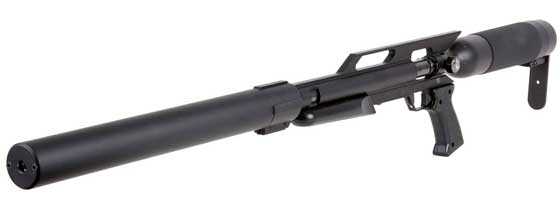
TexanSS big bore air rifle from AirForce.
This report covers:
- First comments
- Bubble Leveler
- Collar Buttons are a no-go at 100 yards
- 210 SWC is still a great bullet
- Balle-Blondeau-talk
- Balle-patent
- Balle Blondeau
- 355-grain flat point dogbone
- Ton shoots at 100 yards
- One more test
I had the Umarex Gauntlet out to shoot at 50 yards last week but the day was just too windy. Once I got it sighted-in for 50 yards the wind picked up and blew the pellets all around. I wanted this test to be a good one between the magazine and the single-shot tray, and it wasn’t going to happed this day. So I brought out the TexanSS that has no difficulty shooting in the wind.
Today I will show you how the AirForce TexanSS big bore performs at 100 yards. I have spent several days at the range to get today’s results. That’s why it took me so long.
First comments
I will first tell you that the TexanSS is a very well-developed air rifle. The gun shoots a wide range of bullet weights, as long as the bullet diameters are 0.457 or 0.458-inches. There are a lot of .45 caliber bullets out there that aren’t those sizes and you shouldn’t waste your time with them.
The trigger works well. It’s not adjustable but it’s as fine a trigger (both light and crisp) as I have seen on any big bore. The power adjuster works well, though the SS needs it to be set around the 3/4-power level or higher. It’s more sensitive to adjustment than the Texan, which I guess is due to the shorter barrel. I will also tell you that although this SS is not silent, it is remarkably quiet for a big bore rifle of this power (up to 400 foot pounds).
Bubble Leveler
As I mentioned in Part 4 I installed the 4-16X56 UTG Bubble Leveler scope on the rifle. I put the bubble in the center of the vertical crosshair for every shot, knowing I am removing all scope cant from the equation. If that doesn’t mean much to you read this report. At $225, there isn’t a scope on the market that can match the optical clarity and quality of this one — and that’s without the bubble!
Collar Buttons are a no-go at 100 yards
First I will tell you that the collar button and short dumbbell bullets that did so well at 50 yards did not hold up at 100. That was one whole day at the range. I hoped they would astound us, after seeing them perform at 50 yards. But they opened dramatically and gave groups of 7-10 inches.
210 SWC is still a great bullet
Next I tried the Tin Starr 210-grain semi-wadcutter that did so well in the Texan. These did well at 50 yards in the TexanSS. They also performed well at 100. Knowing that the first two shots after the fill were the best, I shot one bullet, then refilled and shot two more. After those two I refilled again and fired the final two bullets. All five bullets were shot on the first or second shots after a fill. After a careful sight-in the first five shots for record went into 2.704-inches at 100 yards. Any one of them would have taken a deer-sized animal.
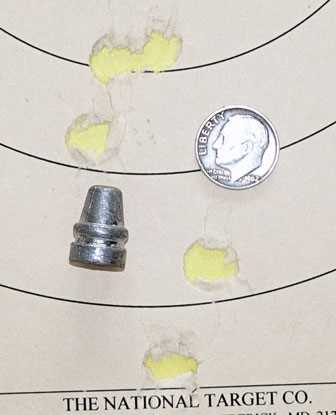
The first five 210-grain semi-wadcutters went into 2.704-inches at 100 yards.
After seeing those shots I adjusted the scope again and fired five more. These were also fired as one shot then a fill and two more and another fill and the last two. These landed higher and are more centered on the bull but not quite as tight, at 3.215-inches between centers. Once again, five killing shots.
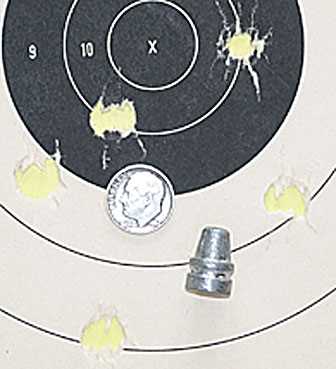
The second five 210-grain semi-wadcutters went into 3.215-inches at 100 yards.
Because I was testing, I did not spend the time to fine-tune the adjustment wheel. It worked well enough at 50 yards with this bullet and I had a lot of testing left to do, so I left it where it was. Undoubtedly if this was the only bullet I shot in this rifle, the power could be fine-tuned for just it.
Balle-Blondeau-talk
Johnny Hill of Tin Starr Bullets (817-594-8511) has been working with me throughout the Texan and TexanSS tests. He is the one who suggested the 210-grain SWC that is so accurate. Well, I discussed the Balle Blondeau-style shotgun slug of the 1960s with him and he liked it.
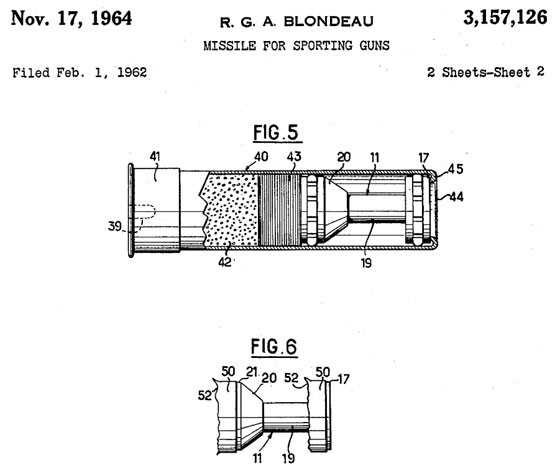
The Balle Blondeau shotgun slug revolutionized the world of shotgun hunting in the 1960s. It can do the same thing for big bore airguns today.
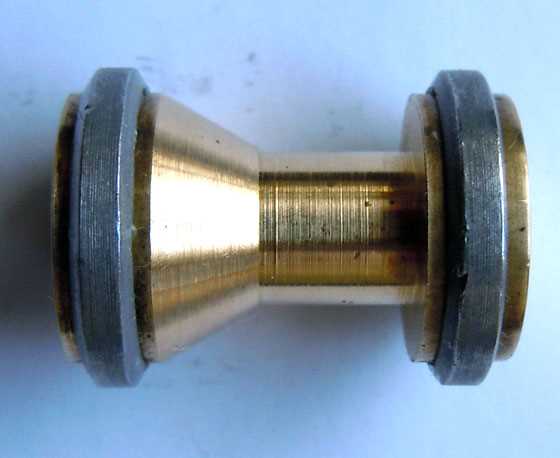
The Balle Blondeau shotgun slug flies straight and true over long distances, due to high drag on its tail.
Johnny tried several designs to see if these were as good as I said. The collar buttons were first, but the flying dumbbells that were so accurate at 50 yards were another successful part of that research. Johnny guessed they wouldn’t shoot well at longer distances because of their lack of weight, though, and they didn’t. He reckoned that a longer and heavier slug was needed — just like the Balle Blondeau. Enter the 355-grain pure lead flat point dogbone!
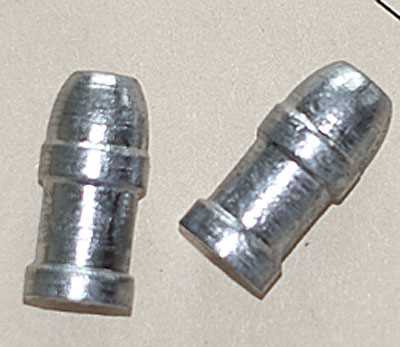
The Tin Starr 355-grain dogbone bullet borrows from the Balle Blondeau.
This is a pure lead bullet, so it will be faster than a bullet with antimony. The harder bullets may look better — these shoot better! I held off reporting the 100-yard test until I could test these for you. Unfortunately on the day I shot this bullet, I was at my buddy Otho’s house. The target was measured by laser as 93 yards distant. The 210-grain bullets had been shot at my club’s rifle range and were exactly 100 yards.
The first shot didn’t even hit the target box the paper target was taped to. Shot number two missed, as well. I had the target box sitting under a gong target, so I held on the top of the gong, knowing I could hear the bullet if it hit metal. Instead, the bullet landed 18 inches below my aim point, striking the target. From there it was easy to adjust the scope to hit the target. Then I fired five shots for record.
The first shot wasn’t loaded deep into the breech, but I thought it would be okay. That was a mistake I was to discover in a bit. That first shot hit high on the bull. The next 4 shots were all seated deep in the breech and landed together about 4 inches below the first one. Shots 2 through 5 are grouped in 2.892-inches between centers. That’s very good, but that first shot had me buffaloed until I spoke to Ton Jones at AirForce.
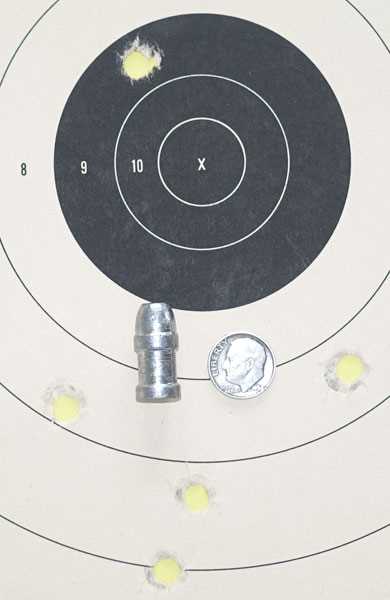
The first shot wasn’t seated deep enough. When I did seat deep the shots went closer together at 93 yards.
Ton shoots at 100 yards
Ton told me in his experience this 355-grain Tin Starr flat point dogbone is extremely accurate at 100 yards, as long as it is seated consistently deep. He said the bullet holes of the first and second shots will touch at that distance. I asked him to test it for me. Yesterday he did that. He sent me a picture of 7 shots at 100 yards that is better than the 6 shots I had fired with the Texan several years ago. And his distance was a true hundred yards, as measured by laser. Since we know an American quarter is just under an inch in diameter, this 7-shot group has to be around 1.25 inches at 100 yards.
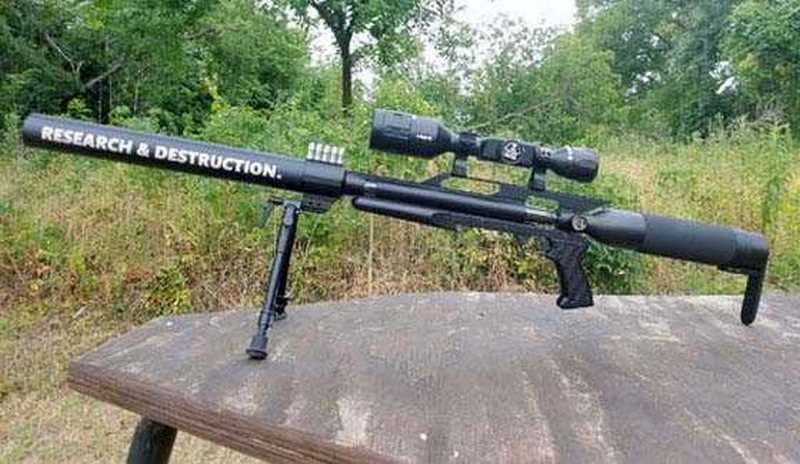
Ton Jones tested the 355-grain dogbone bullet at 100 yards in his TexanSS.
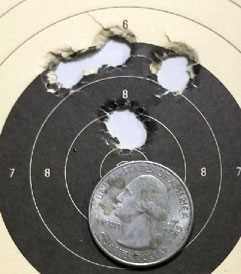
Ton Jones put 7 355-grain dogbone bullets into about 1.25-inches at 100 yards. Three on top at the left, 2 at the right and 2 above the quarter.
Ton seats each bullet to the same depth, which is the base of the bullet. He doesn’t want to allow the bullet to cock sideways inside the bore and the two driving bands prevent that. If he can’t seat the bullet that deep he blows the shot off. That impressed me, because it’s the same sort of thing a blackpowder shooter would do.
One more test
I will test the TexanSS one more time, and this time I will seat the 355-grain flat point dogbone bullets consistently deep to their base. I have the power adjustment dialed in correctly (I think). Now it’s time to get the seating right, as well. Stay tuned!

B.B.,
LOOKING GOOD! I have never had luck out beyond 50 with collar button and other short bullets in my .575, .458, .308 DAQs either! Both of your groups are very good for Big Bore at 100; Ton obviously knows his Texan SS. I also applaud his choice of name for his rifle! I think you need to take his use of a quarter instead of a dime for a Big Bore scale provider under consideration…. Only some really infrequent 3+ shot groups will not show from under a quarter when the rounds are so large in diameter. Even a five shot cloverleaf one hole will peek out.
How do I contact Tin Star to discuss the possibility of some slugs to try for my DAQs? TIA!
shootski
shootski,
Tin Starr is the Weatherford Pawn Shop.
weatherfordpawn@yahoo.com
B.B.
B..B.,
I forgot to ask!
Any feel for the MVs you got. I would guess high 800 to me 900s?
The holes all look like stabe flight at impact.
shootski
B.B.,
100 yards! What a treat and big bore to boot! 🙂
2 questions,….
1) The Balle Blondeau (original) looks to be turned on a lathe and the outer rings appear to be a different material. Yes?
2) How is your muzzle velocity compared to Ton’s? I would think that a near exact match might be ideal if you are trying to copy Ton’s results. At least within 25 fps I would think.
I do not recall collar buttons being mentioned before. I will have to look that up. The Balle Blondeau reminds me of front to rear weight ratio factors and arrow design. It also reminds me of a conventional Diabolo pellet,.. and a dog bone. All very interesting,.. and slightly confusing. 😉
Looking forwards to more.
Good Day to you and to all,….. Chris
Chris,
I think the Balle Blondeau was turned on a lathe and the rings are a synthetic, maybe Teflon?
Ton and I have our rifles set at the exact same place, so the velocity is very close.
Part 3 has the velocity data.
B.B.
BB,
If you keep this up I just may have to allow one of these to move into The Home.
BB,
It is a shame you do not have some of these to try out.
https://lethalprecision.com/shop?olsPage=products%2Flethal-air-diablo-457-50-ct-182-gr
RR,
Didn’t you see what I tried in Part 3? I tried a “pellet” but it was too big to load. This 355-grain bullet is the best
I have seen in the TexanSS.
B.B.
BB,
I had forgotten, but these are from Lethal Precision here in Virginia and are sized to .452 or .457. You could contact them and maybe they may like the idea of your testing their pellets. I am certain we would not mind and extra segment or two to this review. 😉
shootski,
Going back to the Part 3 Velocity test, the 355-grain bullet was probably leaving the muzzle in the high 600s.
B.B.
B.B.,
Sorry.
I went back and reviewed all of the prior parts of this report!
I will try the Tin Starr email you provided since that will get answered on their/his schedule; unlike phone calls.
I’ll need to get my questions and wording right and avoid sounding all too dumb!
You must be from the liniage of Jobe.
Thank you.
shootski
BB
Wasn’t the Balle Blondeau used in that smooth bore air gun by the father a son team that some kind of competition? I think I brought that up before and can’t remember exactly.
But what I’m getting at is I thought that was a smooth bore design. Like using it as slug in a shot gun smooth bore barrel. Maybe not necessarily a rifled barrel designed projectile.
And one other thing. You mentioned noise was good for the big bore shrouded Texan SS. I would have to say it’s probably a heck of a lot more quiet than a fire burner making that makes equal fpe. And usually the fire burners ain’t silenced either. I would like to hear a Texan SS shoot.
GF1,
Good memory! The Chilkos made a dumbbell-shaped bullet for both their smoothbores. The bullets were lead and not true Balle Blondeaus, but they had similar characteristics.
Gary Barnes went on to copy the Balle Blondeau after he saw what the Chilko guns could do. He did very well out to 200 yards.
The Balle Blondeau was designed for a smoothbore. Rifled shotgun barrels are a more recent thing.
B.B.
Thanks BB.
I knew there was a discussion about that a couple times back in the past.
And now days they have those slugs for shot guns that actually have a rifling twist on the outside diameter of the slug.
But what I think is cool is the Balle Blondeau doesn’t need rifling for stabilizing.
And on the bullets your using in the Texan SS. Is the tail end concave or is it flat? Is the Texan SS sealing the bullet with the rifling engagement? Or is there some what of a skirt that may be trapping air?
It just always makes me wonder where the air seal is coming from when bullets are used in air guns.
GF1,
The bullet base is flat. The fit of the bullet in the bore does the sealing.
B.B.
BB
So fit of the bullet is probably more critical than the fit of a pellet skirt. The skirt will blow out and seal with a pellet.
I don’t remember if you mentioned if you ever tryed slugging the barrel on your Texan SS. What I mean is loading a bullet and pushing it down the bore and measuring the outside diameter of the bullet to see if and how much it sizes down the bullet.
B.B.
100 yards vs 93 yards, does 21 feet make that much difference?
-Y
Yogi,
Not really. But to some folks it does, so I mentioned it.
B.B.
B.B.
Sorry, I thought that you mentioned it because of the increased pellet drop on those 21 feet. Would you need to re-sight in your scope? Don’t heavier pellets drop faster than lighter ones?
-Y
Yogi,
Not according to Galileo, they don’t. But slower projectiles drop SOONER than faster ones.
Yes, at the low velocity this bullet travels, 21 feet is significant. It might amount to 2 inches, or so.
B.B.
BB
But at what point does the velocity drop affect accuracy at a given distance is the question.
If it drops 2 inches no big deal if you still get accurate groups.
Shooting in a given distance is what will give you the best accuracy. The farther out you get the more things stack up against you.
Some projectile designs coupled to certain guns have a range of accuracy at a range of distances that is better than another gun or projectile.
Kind of like finding that working range of pressure with a PCP gun. Only your finding the range of distance the projectile works best in.
If that made any sense.
GF1,
You should read the Army’s test of the 45/70, back in the early 1870s. They found the bullet remained accurate even after it had slowed down to 600 f.p.s.
B.B.
BB
I can believe that.
I don’t have any experience shooting bullets that slow but I have with different caliber pellets. And I should say with some good results with certian guns at longer distances.
It’s about getting the right combination.
And from what I have seen with the 3 different AirForce guns I have had that the Texan should do very well like it’s smaller brothers do at longer distances.
I just recently went up to 6 on my power wheel on the .25 Condor SS I have. And down on fill pressure to 2050 psi to 1150 psi.
I was on 3 on the power wheel and filling from 2500 psi down to 1600 psi.
I’m now pushing JSB 34.95’s at 950 fps. And what’s nice now is I don’t have to do a initial first shot to knock the valve into action. It’s firing right on point first shot out. So definitely happy I tryed some more power wheel and fill pressure testing.
But here’s a question. If a person has owned some .25 caliber AirForce guns like the Talon SS’s and Condor SS. Would getting a Texan SS be pretty straight forward in tuning like it’s little brothers?
Now you aroused my curiosity. Without electronics and a chronograph, how did the Army in the 1870’s determine the bullet traveled at 600 ft/sec or any other velocity? I’m sure some enterprising individual came up with a unique methodology.
B-I-L,
It was done with math and things like time of flight and penetration in a solid medium at the target. In the 1980s the Army proved a lot of that with millimeter wave radar. Their physicists though that a blackpowder rifle that shoots a bullet at 1,250 f.p.s. could not shoot a mile — to say nothing of two! They were proven wrong. This all revolved around the Billy Dixon sniper kill shot of 1,535 yards at the second battle of Adobe Walls.
B.B.
B I L
I just read BB’s response to you.
That stuff interests me.
I have many times shot air guns into a pine 2×4 with different guns at different velocity and wait pellets along with chronying those guns.
Once you do it enough you can tell pretty good how fast that pellets going by penetration.
And of course that’s having a chrony. Back then math and no chrony is cool too.
I don’t know if this is what my dad did. But I do sure remember him using his slide rule alot when I was a kid on the farm. He was a surveyor and a sniper in the Korean war. And he did shoot long range at the farm alot. And I know he tryed to teach me the slide rule. But man those things got to many numbers.
And how many times have I brought that up about splatology. Matter of fact me and Halfstep was talking about that a little while back.
I even posted some pellets I recovered to show the comparison of weight velocity does.
B-I-L,
I knew I remembered something from back in B.B.s Airgun Newsletter days:
/blog/2009/09/splatology/
SPLATOLOGY!
But B.B. also used it on this blog some time ago; efficient little devil that he is from time to time, Lol! So I just linked to it! I learning efficiency too B.B.!
A reader of that blog also provided an interesting link:
http://www.the-long-family.com/group_size_analysis.htm
Old time ways of measurements of velocity and a great tutorial about group size measurement.
shootski
BB
And I just caught myself. What was I thinking. I do have exsperiance with slow velocity bullets. Not down at 600 fps. But definitely down at 700-900 fps.
The low velocity .22 rounds. The 60 grain 950 fps Aquila sub sonc sniper rounds. Better known as the SSS. And the 710 fps CCI 40 grain long rifles. Both my Savage 93 and my old Winchester 190 shoot them fine out at a 100 yards +.
I guess I should of said shooting air guns with bullets that slow. 🙂
Love this stuff on bullet design! I have no real application for a big-bore (don’t hunt deer anymore) but the attraction is in the bullets themselves.
Johnny Hall is having much to much fun for me not to want to join in 🙂
On a similar note, I’m intrigued by the raised band/belt around the circumference of the Dust Devil BBs and finally got around to doing a bit of a test with them.
I tested a golf ball and a sponge rubber ball (with and without a raised band around their middles) by suspending them is the air-stream from my compressor just to see what they would do.
The balls without the band would spin in a random manner with a fair amount of oscillation where the banded balls showed a tendency to spin around a fixed axis and oscillate less.
I had expected that the raised band would cause the ball to “weather-cock” and align it’s rotation in the direction of the band (like a tire) and was surprised that the ball oriented itself to spin at 90 degrees to the band.
My tests were pretty crude as my little shop compressor lacks the volume to suspend the ball for more than 10 – 15 seconds before running out of steam and losing stability. I have no idea what the airflow velocities were when the balls were steady. Still it was interesting to see.
Was curious about the aerodynamics of the Dust Devils, guess that the best test is just to shoot them and compare the accuracy against regular BBs.
Hank
Hank
That’s what I thought in my mind the Dust Devil’s would spin like.
So in a smooth bore ok. Wonder what would happen in a rifled barrel. I would say the spin of the Dust Devil would have a random spin pattern from one shot to the next. In otherwards rifling might not be a good thing for Dust Devil’s.
But you never know. Maybe rifling and Dust Devil’s may just surprise us.
GF1,
With my “tests”, when first levitating the ball it would spin in random directions before settling to the 90 degrees to the band axis I show in the picture.
I have always equated BBs and a smooth bore – would never put a steel (or other material harder than lead pellets) in a rifled barrel.
Think that any sort of tube that touches the BB will impart some sort of spin. The idea that the Dust Devil might stabilize itself in free-flight and have a positive effect on accuracy is interesting. Need to do some shooting to see.
Hank
Hank
Yep no way would I put a bb down a rifled barrel that I care about. And I still think a bb is centered in the bore by a cushion of air. Or does it glance off the inner barrel at various spots before it leaves the barrel. Maybe that’s what happens with a bb when it goes down a rifled barrel. After all a bb is undersize to a .177 pellet barrel. And maybe the bb does start to spin in a rifled barrel with the twist rate because of air flow???
I still would like to see a bb shot out of smooth glass tube with markings on it for rotation. Then slow the video down to see if the bb in fact does float in the center of a cusion of air surrounding it.
Then maybe bb’s and Dust Devil’s shooting in a clear rifled barrel. That is if they could make such and still see through it.
OH, forgot to mention that the airflow would be from left to right in the picture.
Hank
Oh no. You would have to say that. Why would it matter. Maybe it would be from right to left. You see what I mean.
Or do we want to throw in the Coriolis effect. Would it make a difference at what position you live to the equator. 😉
Hank,
Thanks for the information about the air stream orientation. Helps me put my head around the aerodynamics. I think you have shown us the secret of Dust Devil accuracy! I wonder if you went with a miniature nozzle you could fly an actual Dust Devil and see if it behaves the same?
How long did the big models take to settle into the final steady state of spin?
shootski
Shootski,
I thought about testing the actual Dust Devils but that would have meant a lot more setup. Machine a miniature nozzle, making a stage, rigging up a fine control on the air source and recording it all with a camera. Working on a couple of other things and didn’t have time to do all that just to satisfy my curiosity.
The big models would bounce, oscillate and spin randomly until I got the airflow straight vertical and steady (needed about 90 psi for the sponge ball and almost 100 psi for the golf ball) then they would stabilize quite quickly. When my 8 gallon tank dropped down and the compressor kicked in the airflow would not be as smooth and the balls would lose stability fast.
h
Hank,
No need for extra work on my part. You answered my big question that the models stabalized quickly with smooth airflow. We can speculate that the Dust Devils will do the same once clear of the muzzle. I think it is the drag and push of the airflow that makes them spin 90° out from what most of us probably expected. Those aerodynamic loads have an interesting distribution over the surface of the spinning Dust Devil/model I wonder if we could find out if they really were designed for just that effect or if it was just serendipity?
shootski
Shootski,
The guy that designed them has some background. I would place my money on “designed”.
Hank
But remember how does the air make it to a bb when it’s in the barrel. It comes from behind. And it’s not pointed to one side or the other. It’s how ever the transfer port lets the air flow.
So no telling how it would induce the spin. Then another thing is. Is the bb in the barrel long enough to get that spin started.
This would be a good discussion for when bb does the next Dust Devil report. Maybe the person that invented them will chime in.
GF1,
I use the Comment RSS,… so,… I see “all”! 😉 In theory, I think that the Dust Devil’s use a spinning top theory,.. or like a motor cycle wheel spinning holds the bike upright. THEN AGAIN,… Hanks test showed just the (opposite) rotation.
All in all,… (very) interesting.
Out’a here,… up all too early. Chris
Chris
See that’s another thing. It would probably depend on how the Dust Devil was oriented in the barrel in relation to how the air hits it as to witch way it will induce spin.
But maybe the air blast hits the Dust Devil bb so fast and hard that it just push’s the bb down the barrel before it gets a chance to spin. Maybe the spin starts happening after it leaves the barrel. And on that note maybe as distance increases a Dust Devil bb may get more stable.
GF1,
After further thought,.. Hank did say that they took a while to stabilize. So, I think they will stabilize in flight. Maybe the higher the fps, maybe the stabilization and accuracy would be better?
Your test of how the bb floats on a cushion of air as it goes down the barrel is something else.
Chris
Bottom line we can talk all about theory’s. But in reality as I always say.
Got to shoot at some paper. That’s what counts.
Yup, the heck with theory – shoot paper!
GF1,
I agree with your comments on how a BB would react to the airflow in a barrel – makes sense.
Testing that would take some doing as the “model” BB would have to be travelling thru the clear barrel and video taped. Not as easy as floating a ball in in an air stream.
Hank
Hank
Also the flow around the bb. Will be different in a barrel than out in the open air like you tested.
So to truly see the glass tube would need set up like the barrel it’s replicating.
And like you say a video to capture everything. Would all be a bit of a challenge to do. But would be cool to see no doubt.
Hank
Yep paper.
Hank,
Thank you very much for that test. I have been wondering ever since you mentioned you wanted to try it. To me, that is surprising. It is very good to know for sure,… at least with your test subjects.
Very nice and thank you again.
Chris,
Glad to share 🙂
Know you like that sort of thing!
h
Hank,
HEY,….. above all,… you made the darn experiment (work)! That says a lot right there on your skills alone. Very nice. An (actual) test of a Dust Devil would be the ultimate! Of course,… when and if you ever get the time. Video too! 😉 The clear tube idea that GF1 mentioned has some merit, but it was more for air float theory. That would/could be a combo theory test?
At any rate,… with you working and all,…. time is limited. Or?????,…. do I recall that you recently…..
Chris 😉
(Hey,… I do not want you just sitting around, watching TV and getting all fat and old,.. and “stuff”). I am looking out for your own good! 😉
Chris
I just made a comment above to Hank.
Read it. It’s about the air flow from the transfer port in a barrel and how it reaches the bb. And about the bb going down the barrel.
Chris,
Thanks for your concern about me getting old and fat 🙂
Can’t do too much about the “old” part but since I retired I am steadily losing weight. Other than the occasional Netflix movie I never watch TV so no problem there. Lots of projects on the go.
Have a good one eh!
Hank
Hank
I like your experiment and how it showed spin orientation. A thought I had about the air source is that volume is more important than the pressure. If that is true then the output side of a shop vac would be better than a compressor. Thanks for your hard work.
Gerald
Gerald,
Good idea to use a shop vac! I have a powerful one and will try it out and post the results.
Hank
BB
Do you know what scope Ton has on his gun?
GF1,
I will ask.
B.B.
BB
Ok thanks.
GF1,
Ton told me it is an ATN (American Technologies Network) 4K. That is a 3-14 night vision scope he uses for hunting.
B.B.
BB
And I’m sure you knew I was going to search it.
Heck it’s even got WiFi and it’s HD. Pretty cool.
https://www.atncorp.com/x-sight4k-pro-day-night-rifle-scope-5-20x
And this is a 5-20x. I couldn’t find the 3-14x.
Still yet nice scopes.
Wow! That scope looks like something from Star Wars. It’s about as high tech as one could get 🙂
Geo
Did you get you click on the video’s?
The scope view shows what direction your pointing in real time and and inline angle, range your shooting at and wind direction.
If I had the extra money right now I would have one of those scopes. That’s right up my alley if you know what I mean.
GF1,
No,… I did not click on the videos. It is a work night and time is limited. I will check them out over the weekend. It does sound interesting.
Chris
Yep let me know.
Yes! Man, that’s really something. I didn’t know stuff like that even existed. Looks like something you would see in a video game, not on a real rifle.
Geo
You know what you just may be on to something.
You know how a sport or activity always tries to get youths involved. Like fishing or shooting and so on.
Well this may just be the ticket to get the younger generation involved in shooting. They all are usually pretty heavy into video games.
I have a iPhone adapter that’s called a iScope. It’s pretty simple. It’s a back cover that fits my phone and is attached to the iScope adapter. I’ll show a picture in a second of mine. And I had to go down to the local Verizon store and buy the back case or plate or whatever it’s called because the iScope adapter didn’t have one to fit my phone.
Anyway it’s like watching a video game when you shoot with the full screen or a scope view if you reduce it down. I can take video’s or a picture of what I’m shooting at. I can even play the video of me shooting on my big screen TV from my phone.
Me and my daughter’s have used it. They love it and it’s how I taght them holdovers and understand because I could see what they see when they shot.
Here’s a link to the iScope and a couple short video’s from my phone. The only thing different in a sense is I don’t have the data flashing on the screen and I’m not looking through a scope.
http://iscope.com
Here’s a couple short video’s from my phone that I shot. Scope view and full screen. And I got more. I even got pictures of the moon from my scope. And not to rub it in. But see this is just a touch of what a smart phone can do. Sorry I had to say that. 🙂
https://www.youtube.com/watch?v=OljUs1TXEM8
https://www.youtube.com/watch?v=n6OhKR4-JSM
https://www.youtube.com/watch?v=qw4NuXElIfA
Geo
Forgot the picture of my iScope adapter. And don’t make fun of the color. It’s all they had that would fit my phone. And yes I had to drill holes in the back cover to use the screws from the adapter to mount it to the iScope adapter. And again that’s because iScope didn’t have one that fit my phone.
Geo
And you can slow each video down on the you tube link to see the video better.
Just checked the link again after I posted it. It does also have the 3-14x. Check it out.
Ton,
Excellent shooting!
Michael
B.B.,
This remindes me of shooting black powder without all the cleanup. I was not able to find the twist rate on the TexanSS barrel. There were a mulitude of bullet shapes for the muzzel loaders but their accuracy was significantly influenced by the twist rate. Trying to match some of the old bullet shapes and rpm for accuracy may provide some insight. I am sure someone is already doing that though. With this caliber and power some long range accuracy way beyond 100 yards should be achievable.
Is the kick similar to black powder? More of a hard push.
Don
Don,
I think the twist is 1:20 or slower. The kick is a soft push that’s slower than black powder.
B.B.
I was just looking at the bullets available for black powder most of them now are jacketed and or sabot I guess that is the influence of the breach loading black powder rifles although most of them are muzzle loaders. I guess that is to still meet the muzzle loader definition.
I also looked at the multitude of black powder substitutes, I remember Pyrodex but all the rest are new to me.
Some of the new black powder rifles guarantee MOA at 200 yards.
Guess I am a Dinosaur when it comes to black powder.
Don
Don,
The current accepted long distance Big Bore record is hel by an AirForce Texan at 1250 yards using a Cold Shot base. Almost out to Billy Dixon ranges! You can see the video of the shot (take note of the steep arrival angle of the slug and the bore to scope angle!) as well as the adjustable base it took to do it on this llnk:
https://heritage-arms.com
shootski
Shootski,
Nice link. That explains the product pretty well. I do however see the need for one as I do not plan to shoot past 100 yards. Though,… I would if I could. Thank you.
Shootski,
Rather,… (not) see the need for one. I do love the entire concept and design though.
Benji-Don
That’s what I relate big bore air gun shooting to also. Black powder.
B.B.,
I have had good luck with my M-rod (.25) from time to time. I did two sub -2″ inch groups recently at 100 yards. I have done sub 1″. 8 shot.
So a question,…. is it easier to shoot a sub 2″ inch group at 100 yards with smaller caliber air gun (.22 or .25) or a bigger caliber (.30 plus) air gun? Which would you have a better chance with?
Or, was I just lucky?
Chris
Chris,
I have very little experience shooting at 100 yards, but I would go with the .25. It’s heavier than the .177 and less likely to get blown around and the .30 caliber pellets are not as developed.
But that’s just my opinion.
B.B.
B.B.,
After I posted,… I thought the same thing on having better pellet development for smaller calibers. I think,.. at least me,… that larger bore air gun ammunition is still in it’s infancy,… as you said. It definitely looks cruder.
As things progress,… I think that (specific) twist rates, ammo grain and fps will lead to pellet specific air guns. Given the right controls in performance (mainly low fps spread),… (and reasonable quality),.. it would take a lot of guess work out of trying different pellets and tunes. I see trends in this already.
Out of the box performance, so to speak. Good or bad,… we in the U.S. are known for our liking of ease and convenience. (hey,… it works for the massive frozen food isle,.. a.k.a.,….nuke/heat and eat). NOT a fan. But hey,… it must be selling.
Thank you,…. Chris
P.S.,… “it” just left Indiana today. 😉
Chris U,
Do you have a scope on the way?
Don
Don,
I have not had time to do what I would consider good research yet. It supposed to be rainy and hot here this weekend, so maybe I will get some research time in. It may just come down to a 6-24 or 8-32 UTG as B.B. still highly recommends them.
Chris,
You said, “Or, was I just lucky?”
You may find the link:
http://www.the-long-family.com/group_size_analysis.htm
It is just theoretical since it has not been tested by clearrepliction.
But I think thewritr is on to something that explains THE DREADED FLYERS!
If his theory is correct FLYERS are mostly the outliers unless they miss the paper altogether!
I have quietly stopped bragging about my group sizes since studying his theory!
I think it also explains what the difference is between small medium and Big Bore expectations of impact size!
shootski
Shootski,
I am ahead of you. 😉 I saved the same link from your previous post. Yes!,… it did look very interesting. I very much look forwards to reading it.
(Thank you) for your insight and assistance. Now,.. I just need to be retired so that I have the time and gumption to play around with it all!
Chris
Chris U,
Dont wait till you retire, you will have less time believe me. A two hour job takes metwo days and my calendar is always full.
I had a list of things to do when I retired. After a little over a year I threw it away. I guess there was a reason I did not do them before I retired. I love retirement but time will not be your friend.
Don
Don,
Thank you for that sage advice. As for time, I may be smarter, but I am pretty sure time has done nothing beneficial for the ol’ bones and joints. 😉
Chris
The question I’d do you think you was lucky.
The more you shoot a gun the more you learn about it.
But just a note. In the small bore air gun caliber. .25 has shown the easiest repeatability out at a hundred yards and past for me.
I haven’t shot any big bore yet. But alot of competitors in the long range air gun bench resting competition use .30 and 35 caliber.
So I would say again the right combination with a big bore air gun can be good.
Search about that competion and I bet there will be some good info there.
Chris,
I’m retired again… surprisingly I still need to block in a schedule to get most of what I must do and what I want to do done. I had a whole day scheduled for sod lawn replacement…it rained real hard and the clay sucks your boots off so I had some unexpected down time to sort through my BIG BORE information and links.
Also I concur with B.B. on the .25 call. Event though I remember he was not in favor of .25 once (late last Millennium) for the same reason he advised against the .30 cal. now. I think that quality .30 availability will change in the mid to near term too!
shootski